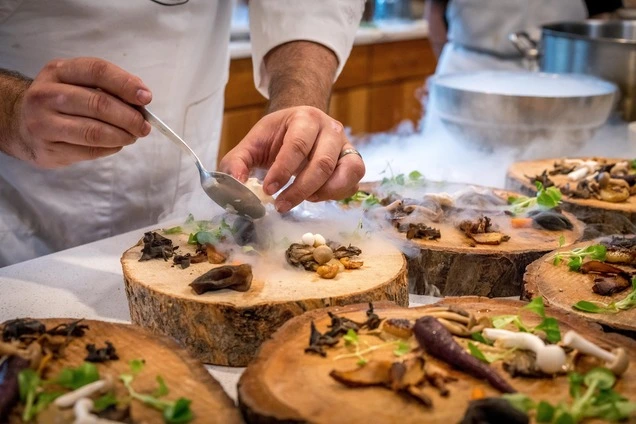Embarking on a culinary journey through North Korea unveils a realm of unique flavors and dishes, offering a distinctive twist to the familiar elements of Korean cuisine. While international influences are less pronounced in the North, the culinary landscape here boasts a more traditional, home-style feel. Let’s delve into the top 10 lesser-known North Korean foods that add a delicious layer to the gastronomic tapestry of the Democratic People’s Republic of Korea (DPRK).
Ostrich BBQ
Ostrich meat and eggs take center stage in North Korean cuisine, serving as substantial sources of sustenance for both the military and the populace. The Ostrich Farm near Pyongyang offers a tantalizing experience with ostrich BBQ, showcasing the versatility of this unique meat. From giant ostrich eggs in supermarkets to a variety of ostrich goods at the gift shop, this delicacy is a must-try for adventurous foodies.
Injo Gogi Bap
Injo Gogi Bap, translating to “rice with artificial meat,” is a testament to North Korea’s resilience during the 1990s famine. Made with rice, kimchi, soybean paste, and soybean oil, this street food favorite mimics a meat-like texture. A dish born out of necessity has become a beloved part of North Korean culinary culture.
Gongmiri
On the east coast city of Wonsan, fresh seafood takes the spotlight. The pier, lined with local fishermen and al fresco eateries, is a haven for seafood enthusiasts. Dive into the experience with “gongmiri,” a long silver fish served as sashimi. The combination of locally caught fish and the backdrop of the East Sea of Korea creates an unforgettable culinary experience.
Petrol Clam BBQ
Nampo, on the west coast, introduces a daring culinary adventure – the infamous “petrol clam BBQ.” Local clams are arranged on a slab, doused with petrol, and set alight to cook in their shells. This unconventional method results in a unique and authentic local delicacy, showcasing North Korea’s culinary creativity.
Talpi
Talpi, or cured and dried pollock, stands as the quintessential beer accompaniment in North Korea. Shredded into jerky-sized pieces, this dried fish is a favorite during beer-drinking sessions. Paired with soy vinegar and wasabi, talpi provides a savory, salty counterpart to the renowned Taedonggang beer.
Duck Heart
For the adventurous palate, a hidden gem awaits at the Pyongyang Duck BBQ Restaurant – grilled duck hearts. Though not on the menu, these succulent delights showcase North Korean culinary prowess, offering a rich source of protein and saturated fatty acids.
Pine Mushrooms
Considered a delicacy akin to truffles, pine mushrooms from the Chilbo Mountain region are a gastronomic delight. Lightly roasted on a gas cooker or BBQ, these mushrooms boast a complex flavor profile. Gifted by Kim Jong Un to South Korean President Moon Jae-in, they are a testament to North Korea’s culinary treasures.
Pansangi
A trip to the DMZ brings forth the opportunity to savor “pansangi” in Kaesong. This traditional dish features multiple bronze bowls filled with an array of side dishes, reflecting the historical importance of a dinner guest. Kaesong, spared from the ravages of war, provides an ideal setting for this delightful experience.
Sea Urchin
North Korean waters harbor some of the highest quality sea urchins globally, rivaling even the cold waters of Hokkaido, Japan. The unique taste of North Korean sea urchins, reminiscent of salted caramel ocean waves, offers a culinary experience like no other. Foraging for fresh sea urchins during specific seasons adds an extra layer of authenticity.
Pyongyang Cold Noodles
Known as “Naengmyeon,” Pyongyang cold noodles are a staple in North Korean cuisine. Served with thinly sliced portions of chicken, pork, and/or beef, along with egg and other toppings, these buckwheat noodles bathed in a cold and light broth are a favorite during special occasions. The mega Okryu-gwan restaurant in Pyongyang witnesses locals flocking for their daily fix of Naengmyeon.
Exploring the lesser-known North Korean foods extends beyond the boundaries of familiar Korean dishes. From ostrich BBQ to petrol clam BBQ, each culinary gem tells a unique story of resilience, creativity, and local flavors. The diverse array of dishes showcased in North Korea adds a rich layer to the global tapestry of culinary delights.
It’s essential to note that the availability of these dishes may vary based on the region and specific circumstances. The descriptions provided are based on cultural insights and may not reflect every individual’s taste preferences. Additionally, travel and culinary experiences are subject to various factors, and readers are encouraged to approach such adventures with an open mind and respect for local customs.

